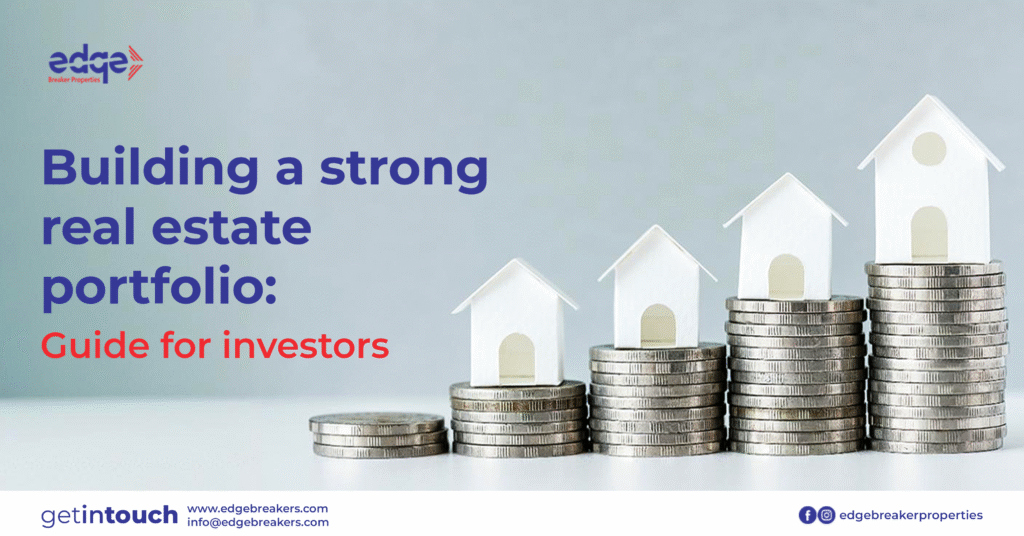Building a Strong Real Estate Portfolio: Guide for Investors

Introduction
Real estate investing has long been a popular way to build wealth and achieve financial freedom. One of the most effective ways to invest in real estate is by building a portfolio of properties. A well-diversified real estate portfolio can provide a steady stream of income, long-term appreciation, and a hedge against inflation. In this article, we will explore the concept of a real estate portfolio, its benefits, and provide a step-by-step guide on how to build a successful one.
What is a Real Estate Portfolio?
A real estate portfolio refers to a collection of properties owned by an individual or organization, designed to generate income, appreciation, or both. It can include various types of properties, such as:
• Residential properties: Single-family homes, apartments, condos
• Commercial properties: Office buildings, retail spaces, warehouses
• Industrial properties: Factories, manufacturing facilities
• Land: Raw land or development land
Benefits of a Real Estate Portfolio
A real estate portfolio offers several benefits, including:
• Diversification: Spreads risk across multiple properties and asset classes
• Income generation: Provides rental income or other forms of revenue
• Appreciation: Potential for long-term increase in property value
• Tax benefits: Various tax deductions and benefits available
Key Components of a Real Estate Portfolio
A successful real estate portfolio consists of several key components, including:
• Properties: The actual real estate assets owned
• Investment strategy: The approach taken to manage and grow the portfolio
• Risk management: Strategies to mitigate potential risks and losses
• Ongoing management: Regular monitoring and maintenance of properties
Step 1: Define Your Investment Goals
Defining your investment goals is a crucial step in building a successful real estate portfolio. Consider the following:
• What are your financial objectives? Are you looking to generate passive income, build long-term wealth, or achieve a specific financial goal?
• What is your risk tolerance: Are you comfortable with high-risk investments or do you prefer more conservative approaches?
• What type of properties interest you: Do you prefer residential, commercial, or industrial properties?
• What is your investment horizon: Are you looking to invest for the short-term or long-term?
Step 2: Assess Your Finances
Assessing your finances is essential to determining how much you can invest in real estate. Consider the following:
• Income: What is your regular income, and how much can you afford to invest each month?
• Savings: Do you have enough savings for a down payment, closing costs, and ongoing expenses?
• Debt: Do you have any high-interest debt that you need to pay off before investing in real estate?
• Credit score: What is your credit score, and how will it impact your ability to secure financing?
Step 3: Choose Your Investment Strategy
Choosing the right investment strategy is critical to building a successful real estate portfolio. Consider the following:
• Residential properties: Investing in single-family homes, apartments, or condos can provide rental income and potential long-term appreciation.
• Commercial properties: Investing in office buildings, retail spaces, or warehouses can provide rental income and potential long-term appreciation.
• Rental properties: Investing in properties specifically for rental income can provide a steady stream of cash flow.
• Fix-and-flip properties: Buying, renovating, and selling properties can provide a quick profit, but it requires significant expertise and resources.
Step 4: Conduct Market Research
Conducting market research is essential to identifying potential investment opportunities. Consider the following:
• Property values: Analyze current property values and trends in the area.
• Rental yields: Calculate the potential rental income and yields in the area.
• Demand and supply: Analyze the demand for properties in the area and the current supply.
• Local economy: Research the local economy, including job growth, population growth, and infrastructure development.
Step 5: Find and Acquire Properties
Finding and acquiring properties is a critical step in building a real estate portfolio. Consider the following:
• Location: Look for properties in desirable locations with good schools, transportation, and amenities.
• Property condition: Consider the condition of the property and potential for renovation or improvement.
• Potential for appreciation: Analyze the potential for long-term appreciation in the property’s value.
• Financing options: Explore financing options, such as mortgages or partnerships.
Step 6: Manage Your Portfolio
Managing your portfolio is essential to ensuring its success. Consider the following:
• Monitor property performance: Regularly review the performance of your properties, including rental income, expenses, and appreciation.
• Adjust your strategy: Adjust your investment strategy as needed based on market trends and property performance.
• Property management: Consider working with property managers or real estate
Step 7: Grow Your Portfolio
Growing your portfolio requires ongoing effort and strategic decision-making. Here are some key considerations:
• Reinvest profits: Reinvest profits from your properties into new investments or renovations.
• Expand your portfolio: Continuously look for new investment opportunities and expand your portfolio.
• Stay educated: Stay up-to-date with market trends, best practices, and regulatory changes.
Building a strong real estate portfolio requires careful planning, strategic decision making and ongoing management. By following these guidelines and staying committed to your goals, you can create a profitable and resilient portfolio that generates long term wealth.
Oluwatosin Damilare
Reference

